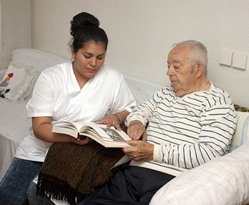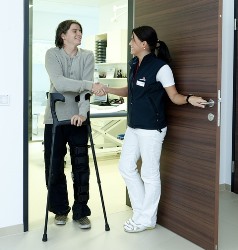How to Pick the Right RN Course near Hartford South Dakota
 Finding the best nursing school near Hartford SD may feel like a complicated endeavor, particularly if you don’t know what to look for in a good degree program. As you may already understand, in order to practice as a registered nurse, you must receive the appropriate education and training to become licensed. So it is vitally important that you research and evaluate the qualifications of each program you are contemplating before enrolling in your ultimate selection. Unfortunately, too many potential students base their selection exclusively on the price of tuition and the nearness of the school. Deciding on the least costly college or the one that is local to your residence is no doubt not the most ideal way to pick a nursing program. There are various crucial additional aspects to explore before you make a decision where to attend classes. But before we delve into that checklist, let’s first discuss the nursing degree options that are available together with what the jobs of nurses are in our healthcare system.
Finding the best nursing school near Hartford SD may feel like a complicated endeavor, particularly if you don’t know what to look for in a good degree program. As you may already understand, in order to practice as a registered nurse, you must receive the appropriate education and training to become licensed. So it is vitally important that you research and evaluate the qualifications of each program you are contemplating before enrolling in your ultimate selection. Unfortunately, too many potential students base their selection exclusively on the price of tuition and the nearness of the school. Deciding on the least costly college or the one that is local to your residence is no doubt not the most ideal way to pick a nursing program. There are various crucial additional aspects to explore before you make a decision where to attend classes. But before we delve into that checklist, let’s first discuss the nursing degree options that are available together with what the jobs of nurses are in our healthcare system.
Request Free Information on Nursing Schools Below
Nursing Degrees Available
There are several degree options offered to become a nurse. And to become a Registered Nurse (RN), a student must enroll in an accredited school and program. A nursing student can obtain a qualifying degree in just 2 years, or continue on to obtain a graduate degree for a total of 6 years. Following are some short summaries of the nursing degrees that are offered to aspiring students in the Hartford SD area.
- Associates Degree. The Associate Degree in Nursing (ADN) is normally a 2 year program offered by community colleges. It prepares graduates for an entry level job in nursing in healthcare centers such as hospitals, clinics or nursing homes. Many utilize the ADN as an entry into nursing and later attain a more advanced degree.
- Bachelor’s Degree. The Bachelor of Science in Nursing (BSN) supplies more in depth training than the ADN. It is commonly a four year program offered at colleges and universities. Licensed RNs may be able to complete an accelerated program based on their previous training or degree and professional experience (RN to BSN). Those applying to the program may want to advance to a clinical or administrative position, or be more competitive in the employment market.
- Master’s Degree. The Master of Science in Nursing (MSN) is usually a two year program after attaining the BSN. The MSN program provides specialization training, for instance to become a nurse practitioner or focus on administration, management or teaching.
After a graduating student has received one of the above degrees, he or she must pass the National Council Licensure Examination for Registered Nurses (NCLEX-RN) so as to become licensed. Further requirements for licensing fluctuate from state to state, so make sure to contact the South Dakota board of nursing for any state requirements.
Click Here to Get Free Information on Nursing Schools Near You!
Why Enter the Nursing Profession?
 Nurses are an integral component of a Hartford SD medical team, and for many patients, their primary care providers. A nursing career opens doors to many opportunities, such as healthcare education, research and specialty areas of practice. Nurses go into the profession for many reasons, among the most meaningful are its personal and practical rewards. Nurses provide personal, one-on-one care to patients. Most patients in a medical facility or home care setting have more contact with nurses than with physicians. Nurses often go into the profession out of a passion to tend to the needs of patients, including in situations of short-term treatment of illness and prolonged care of chronic conditions. This human aspect of the medical profession, as opposed to the analytical or research related elements, is appealing to many who choose to enter into a career in nursing. Nurses have a wide range of applicable skills and can select from a variety of work settings, including home care facilities, physician’s offices, health clinics, community centers and hospitals. Also, nurses can advance into a variety of specialties, such as addictions, critical care, genetics and neonatology. Although most nurses provide personal patient care, others choose to be educators, policy advisers and pharmaceutical representatives.
Nurses are an integral component of a Hartford SD medical team, and for many patients, their primary care providers. A nursing career opens doors to many opportunities, such as healthcare education, research and specialty areas of practice. Nurses go into the profession for many reasons, among the most meaningful are its personal and practical rewards. Nurses provide personal, one-on-one care to patients. Most patients in a medical facility or home care setting have more contact with nurses than with physicians. Nurses often go into the profession out of a passion to tend to the needs of patients, including in situations of short-term treatment of illness and prolonged care of chronic conditions. This human aspect of the medical profession, as opposed to the analytical or research related elements, is appealing to many who choose to enter into a career in nursing. Nurses have a wide range of applicable skills and can select from a variety of work settings, including home care facilities, physician’s offices, health clinics, community centers and hospitals. Also, nurses can advance into a variety of specialties, such as addictions, critical care, genetics and neonatology. Although most nurses provide personal patient care, others choose to be educators, policy advisers and pharmaceutical representatives.
Registered Nurse Job Functions
 Registered nurses are the most extensive occupation in the medical care delivery system. RNs practice in many different medical settings, such as Hartford SD hospitals, family practices, outpatient clinics, nursing homes and even schools. Their general function is to aid doctors in the care of their patients. However, the specific duties of a registered nurse will be dependent on their job or specialization along with where they work. A portion of the duties of an RN may include:
Registered nurses are the most extensive occupation in the medical care delivery system. RNs practice in many different medical settings, such as Hartford SD hospitals, family practices, outpatient clinics, nursing homes and even schools. Their general function is to aid doctors in the care of their patients. However, the specific duties of a registered nurse will be dependent on their job or specialization along with where they work. A portion of the duties of an RN may include:
- Administering medications
- Observing patients
- Performing physical examinations
- Coordinating care
- Managing LPNs, LVNs and nurse aides
- Informing patients and their families
- Managing health records and charts
Nurses with a more advanced degree may have more advanced job duties and responsibilities. Nurse practitioners (NP), for example, must hold a Master’s Degree and generally work more independently than their RN counterparts. They can deliver primary or specialty care services, prescribe medications, and diagnose and treat common illnesses or injuries.
Nursing Online Programs
 Enrolling in nursing programs online is growing into a more preferred way to get training and earn a nursing degree. Some schools will require attendance on campus for a component of the training, and nearly all programs require a certain number of clinical rotation hours conducted in a local healthcare center. But since the balance of the training can be accessed online, this option may be a more practical approach to finding the free time to attend classes for some Hartford SD students. Regarding tuition, many online degree programs are less expensive than other on campus alternatives. Even supplementary expenses such as for commuting and study materials may be lessened, helping to make education more easily affordable. And numerous online programs are accredited by organizations such as the Commission on Collegiate Nursing Education (CCNE) for BSN and MSN degrees. So if your job and household commitments have left you with little time to work toward your academic goals, it could be that an online nursing training program will make it easier to fit a degree into your busy schedule.
Enrolling in nursing programs online is growing into a more preferred way to get training and earn a nursing degree. Some schools will require attendance on campus for a component of the training, and nearly all programs require a certain number of clinical rotation hours conducted in a local healthcare center. But since the balance of the training can be accessed online, this option may be a more practical approach to finding the free time to attend classes for some Hartford SD students. Regarding tuition, many online degree programs are less expensive than other on campus alternatives. Even supplementary expenses such as for commuting and study materials may be lessened, helping to make education more easily affordable. And numerous online programs are accredited by organizations such as the Commission on Collegiate Nursing Education (CCNE) for BSN and MSN degrees. So if your job and household commitments have left you with little time to work toward your academic goals, it could be that an online nursing training program will make it easier to fit a degree into your busy schedule.
What to Ask Nursing Degree Programs
 Now that you have selected which nursing program to enroll in, and whether to attend your classes on campus near Hartford SD or online, you can use the following pointers to start narrowing down your options. As you probably realize, there are numerous nursing schools and colleges within South Dakota and the United States. So it is essential to reduce the number of schools to select from to ensure that you will have a workable list. As we already pointed out, the site of the school along with the price of tuition are most likely going to be the first two factors that you will consider. But as we also emphasized, they should not be your sole qualifiers. So before making your final decision, use the following questions to see how your pick compares to the other programs.
Now that you have selected which nursing program to enroll in, and whether to attend your classes on campus near Hartford SD or online, you can use the following pointers to start narrowing down your options. As you probably realize, there are numerous nursing schools and colleges within South Dakota and the United States. So it is essential to reduce the number of schools to select from to ensure that you will have a workable list. As we already pointed out, the site of the school along with the price of tuition are most likely going to be the first two factors that you will consider. But as we also emphasized, they should not be your sole qualifiers. So before making your final decision, use the following questions to see how your pick compares to the other programs.
- Accreditation. It’s a good idea to make sure that the degree or certificate program along with the school is accredited by a U.S. Department of Education recognized accrediting agency. Aside from helping confirm that you obtain a premium education, it may help in obtaining financial aid or student loans, which are often not offered in Hartford SD for non-accredited schools.
- Licensing Preparation. Licensing prerequisites for registered nurses vary from state to state. In all states, a passing score is required on the National Council Licensure Examination (NCLEX-RN) in addition to graduation from an accredited school. Many states require a certain number of clinical hours be performed, as well as the passing of additional tests. It’s essential that the school you are enrolled in not only delivers an exceptional education, but also prepares you to satisfy the minimum licensing requirements for South Dakota or the state where you will be practicing.
- Reputation. Check online rating services to see what the evaluations are for all of the schools you are looking into. Ask the accrediting agencies for their reviews as well. Also, get in touch with the South Dakota school licensing authority to determine if there are any complaints or compliance issues. Finally, you can speak with some Hartford SD healthcare organizations you’re interested in working for after graduation and ask what their opinions are of the schools as well.
- Graduation and Job Placement Rates. Find out from the RN colleges you are looking at what their graduation rates are as well as how long on average it takes students to finish their programs. A low graduation rate may be an indication that students were displeased with the program and dropped out. It’s also imperative that the schools have high job placement rates. A high rate will not only confirm that the school has a superb reputation within the Hartford SD healthcare community, but that it also has the network of contacts to help students gain employment.
- Internship Programs. The best way to acquire experience as a registered nurse is to work in a clinical environment. Essentially all nursing degree programs require a specified number of clinical hours be completed. Various states have minimum clinical hour prerequisites for licensing too. Find out if the schools have associations with Hartford SD hospitals, clinics or labs and help with the placement of students in internships.
Top Nursing Colleges Hartford SD
Requirements for Nursing Degrees Online Hartford South Dakota
Enrolling in the right nursing school is arguably the most crucial first step to starting a new career in the healthcare industry. There are numerous factors that you must take into account when choosing a nursing college. These aspects will be prioritized differently depending on your existing career goals, obligations, and financial situation. As we have pointed out within this article, it is critical that you pick a nursing school and a degree program that are each accredited and have excellent reputations within the healthcare community. You originally came to this website due to your interest in Requirements for Nursing Degrees Online and wanting more information on the topic Accredited Nursing Degree Programs Online.. However, by utilizing our list of qualifying questions, you will be able to produce a short list of schools to choose from so that you can make your final selection. And with the proper degree and training, combined with your dedication and ambition to succeed, you can become a practicing nurse in Hartford SD.
More South Dakota Nursing Locations
Hartford, South Dakota
Hartford is a city in Minnehaha County, South Dakota, United States. A suburb of Sioux Falls, Hartford lies a few miles northwest of the city. The population was estimated to be 3,364 in July 2018, up from 2,534 at the 2010 census.
As of the census[3] of 2010, there were 2,534 people, 913 households, and 684 families living in the city. The population density was 1,116.3 inhabitants per square mile (431.0/km2). There were 939 housing units at an average density of 413.7 per square mile (159.7/km2). The racial makeup of the city was 96.5% White, 0.6% African American, 1.2% Native American, 0.2% Asian, 0.1% from other races, and 1.4% from two or more races. Hispanic or Latino of any race were 0.6% of the population.
There were 913 households of which 45.3% had children under the age of 18 living with them, 62.2% were married couples living together, 9.4% had a female householder with no husband present, 3.3% had a male householder with no wife present, and 25.1% were non-families. 20.0% of all households were made up of individuals and 7.8% had someone living alone who was 65 years of age or older. The average household size was 2.78 and the average family size was 3.23.
